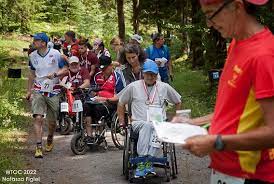Embrace the Adventure: Trail Orienteering for All Abilities

Trail orienteering, often called Trail-O, is a unique and inclusive sport that emphasizes the art of precise navigation over physical speed and endurance. It’s perfect for anyone who loves the great outdoors and enjoys the challenge of reading maps and making strategic decisions.
What is Trail Orienteering?
Trail orienteering is a form of the orienteering sport where participants navigate a course along defined trails or paths using a detailed map and compass. Unlike traditional orienteering, which might involve sprinting across varied terrain, Trail-O focuses on accurately identifying specific locations or “control points” along the trail. This makes it accessible to people of all ages and physical abilities, including those with mobility impairments.
The Allure of Trail Orienteering
-
-
- Precision Over Speed: The essence of Trail-O lies in making precise decisions rather than racing against the clock. This makes it a mentally stimulating and rewarding activity.
- Inclusive and Accessible: Designed to be inclusive, Trail-O courses are typically wheelchair-friendly and accessible to all. This ensures everyone can experience the joy of orienteering.
- Scenic Exploration: Trail orienteering allows participants to immerse themselves in nature, exploring beautiful landscapes at a leisurely pace while engaging in a rewarding mental challenge.
-
Essential Gear for Trail Orienteering
To embark on a trail orienteering adventure, you’ll need some basic equipment:
-
-
- Map and Compass: A detailed orienteering map of the area and a reliable compass are your primary tools. The map should include detailed information about the trails and control points.
- Comfortable Footwear: Wear sturdy, comfortable shoes suitable for walking on trails. Waterproof footwear can be helpful if you encounter wet conditions.
- Weather-Appropriate Clothing: Dress in layers to adapt to changing weather conditions. Consider carrying a lightweight rain jacket and a hat for sun protection.
- Hydration and Snacks: Bring water and energy-boosting snacks to keep yourself hydrated and fuelled during the event.
- Portable Seat: If you prefer to take frequent breaks, a portable seat or cushion can be useful.
-
Tips for Success
-
-
- Study the Map: Before starting, take time to study the map and familiarize yourself with the course. Identify key landmarks and the locations of control points.
- Plan Your Route: Plan your route strategically, considering the easiest and most efficient paths to each control point. Pay attention to the map’s scale to estimate distances accurately.
- Stay Focused: Concentration is key in Trail-O. Keep a close eye on the map and compare it with the terrain around you to ensure you are on the right path.
- Pace Yourself: There’s no need to rush. Trail orienteering is about precision rather than speed, so take your time to make accurate decisions.
- Practice Map Reading: Enhance your skills by practising map reading regularly. Familiarity with different types of maps will improve your confidence and accuracy.
-
The Reward
Trail orienteering offers a fulfilling experience that combines the pleasures of exploring nature with the intellectual challenge of precise navigation. It’s a fantastic way to engage with the outdoors, sharpen your decision-making skills, and enjoy a sense of accomplishment.
Whether you’re a seasoned orienteer looking for a new challenge or a newcomer eager to try a fun and accessible activity, trail orienteering promises an adventure that’s both relaxing and intellectually stimulating. So, grab your map and compass, and set off on a trail-orienteering journey today!
